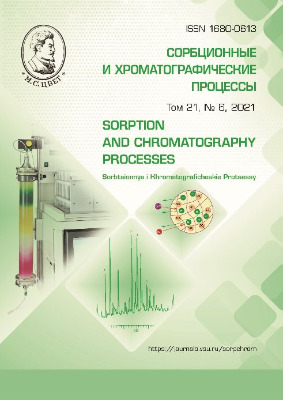The use of a microthermal desorber for the concentration of trace amounts of hydrocarbons in the air
Abstract
The accurate and rapid determination of trace amounts of volatile organic compounds (VOC) remains one of the most urgent problems in analytical chemistry, due to the high demand for the analysis of such gaseous media during environmental monitoring and various types of expertise. Now, the rapid development of instrumentation leads to an increase in the mobility of analytical instruments, as a result of a decrease in their dimensions. In this study the design of a MEMS preconcentrator-microthermal desorber (MTD) based on microfluidic systems is described, and the results of testing this device when concentrating trace amounts of hydrocarbons in air are presented.
The device includes a planar column filled with modified silica gel (60C), to which two gas valves for the inlet and outlet of the analysed gas are connected. The Peltier element acts as a cooling and heating element. To ensure the required temperature conditions in the MTD, a PID controller is implemented on a programmable microcontroller and an electronic board, which makes it possible to automate the MTD operation and ensure that the temperature is maintained within ± 0.3°C during the sorption stage and ± 1.0°C during the desorption stage.
As a result of the research, a microthermal desorber was developed. Based on the example of the determination of pentane and isopentane in the air, it was found that the use of this device in combination with a portable gas chromatograph PIA allows the rapid determination of VOC trace impurities in the air: the time of one analysis cycle, taking into account the concentration stage, was about 20 min. The high sensitivity of analysis using a microthermal desorber was ensured by concentrating VOC by 40-50 times when analysing mixtures of isopentane (0.25-2.5 ppm) and pentane (0.22-2.2 ppm) in the air. A control program for the microthermal desorber has been developed. This program allowed effectively purify the sorbent on which the sorption process was carried out for the subsequent analysis cycle. The small dimensions and high performance of the microthermal desorber allow using it both in laboratories and under field conditions.
Downloads
References
Timmer B.H., Van Delft K.M., Olthuis W., Bergveld P., Sens. Actuators, B Chem., 2003, Vol. 91, pp. 342-346.
Zhang Y., Kato S., Anazawa T., Sensors and Actuators B, 2008, Vol. 129, pp. 481-486.
Wootton R.C.R., deMello, Chem. Com-mun., 2004, pp. 266-267.
Zhang Y., Sun J., Zhu X., Liu J. et al., Sensor Review, 2017, Vol. 37, pp. 137-141.
Michael M., Mark C., Kevin W., McGill R.A. et al., Sensors and Actuators, B: Chem-ical, 2007, Vol. 126, pp. 447-452.
Alfeeli B., Agah M., IEEE Sensors Jour-nal, 2011, Vol. 11, pp. 2756-2762.
Takada S., IEEE Journal of Tansations on sensors and micromachines, 2010, Vol. 130, pp. 207-211.
Ali S., Ashraf-Khorassani M., Taylor L.T., Agah M., Sensors and Actuators B: Chemical, 2009, Vol. 141, pp. 309-315.
Haudebourg R., Vial J., Thiebaut D., Danaie K. et al., Analytical Chemistry, 2012, Vol. 85, pp. 114-120.
Sun J.H., Cui D.F., Chen X., .Zhang L.L. et al., Journal of Chromatography A, 2013, Vol. 1291, pp. 122-128.
Shakeel H., Wang D., Heflin J.R., Agah M., Sensors and Actuators B: Chemical, 2015, Vol. 216, pp. 349-357.
Platonov I.A., Platonov V.I., Kole-snichenko I.N., Gorynov M.G., Sorbtsionnye i Khromatograficheskie Protsessy, 2015, Vol. 6, pp. 754-768.







